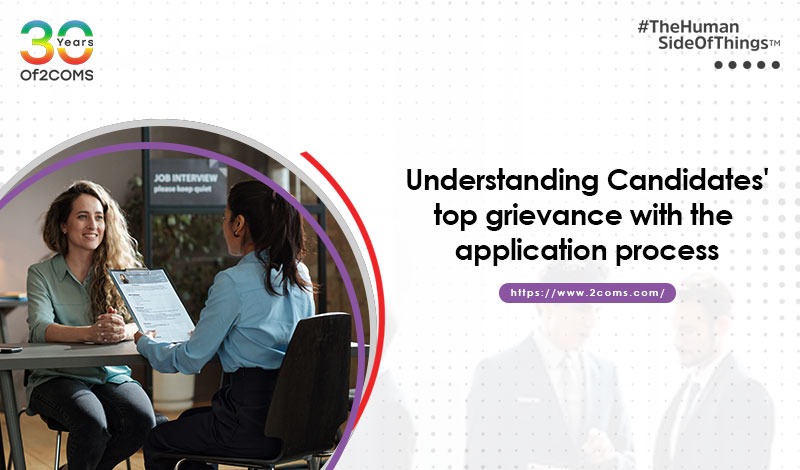In the dynamic and ever-evolving business world, employment opportunities are both more abundant and more competitive.
To row your boat in this fast-paced work environment, automation has come to the rescue, for both the recruiter and the candidate.
We've already discussed in our previous blog how automation has sped up the recruitment process and proved beneficial to the organization. Now, let's examine it the other way around to have a more comprehensive 360-degree perspective and maximize the benefits of automation.
The Application Process
The application procedure is a candidate's primary point of contact with an organization. Since the majority of things are done online these days, the online application process creates the initial impression. This is the place to highlight the core advantages arising from your work environment, growth, and rate of employee satisfaction.
Following this brief overview, the applicant ought to apply for the position, which requires a basic comprehension of the job description. This allows both parties to comprehend the compatibility. This can include simple questions, situational assessments, and preferred locations and work timings.
If this procedure is completely automated and standardized and provides the candidate with the smoothest experience possible, they are highly likely to stick around for the next stages of recruitment.
The Lack of Proper Feedback
In today's job market, feedback is given rarely if at all. There is very little in the way of constructive criticism or feedback. If you are not chosen to continue in the interview process, you are unlikely to receive a rejection letter or any input or advice from the employer as to why you were swiftly passed over. This silent treatment can occasionally have a significant impact on a company's negative publicity.
In order to prevent this from occurring, the hiring party only needs to give a generic response indicating that the candidate's skills do not fully match the present position or that they may apply once they have gained a particular amount of experience. This can also be counterbalanced with the interview portion that went well for them.
By doing this, candidates will feel more clear-headed and be more prepared to face any subsequent interviews in which they can excel.
There are many advantages to providing candidates with honest feedback at the conclusion of the interview process, such as:
- Making sure the applicant's time isn't squandered by providing them with useful information to use in the future.
- Upholding a favorable employer public image which may come into play later on when rejected applicants engage with your company.
- Enhancing the pipeline for potential future talent. Ultimately, losing out on a job doesn't mean that an applicant won't be able to apply again or refer friends and colleagues to your business as an excellent place to work.
Even with a standard rejection letter, staffs still need time to write and mail the letter, and giving a candidate feedback requires further work. Furthermore, the majority of employers like to avoid having a potentially awkward phone call. Automated mailers can help you get through all of this. The candidate won't feel hopeless and will instead be acknowledged more as a result.
Tips for ensuring a positive hiring experience for candidates and areas for future improvement
- At the conclusion of the hiring process, ask candidates to complete a quick feedback survey to learn more about their opinions and possible areas for growth. This can be accomplished through emails, and you can also attach a note of thanks and an expression of gratitude for their time.
- Check employment boards like Indeed and Glassdoor on a regular basis. Analyze remarks made about the interview process. If necessary, the written comments and evaluations you obtain from this could act as a reference for any future adjustments you make to the interview process.
- Keep an eye out for mentions of your business and candidate comments on social media and remain engaged. LinkedIn, Twitter, and Reddit are excellent resources for this purpose. Respond to remarks as soon as you can, and if you can, get more information. This demonstrates your company's responsiveness and proactive nature as well.
- Connect with the latest hires for the most up-to-date experienced feedback. These new hires are some of your most recent and important assets for gauging candidates' hiring and onboarding experience. Find out what they liked, didn't like, and what may be made better from them.
- Have a conversation with the older employees who can be questioned about their perceptions of the degree to which new hires are assimilating into the team and about any suggestions they may have heard regarding the hiring process. For referral hires too, this is a prerequisite.
- Finally, every stage of your hiring process probably has a wealth of analytics data stored in your company's applicant tracking system (ATS). Examine this data to identify any point where prospects typically stop applying. Your area of attention and review should be whatever sticks out. Make use of this tool to track changes over time in important metrics.
Conclusively
Workers are any company's most valuable asset. It takes both individual and collective effort for the organization to grow towards the direction to success. This is crucial that the organization project a positive image to everyone it interacts with, whether they are current or prospective employees. For everyone in the employment market, there must be a thriving spirit to get inside the organization as soon as they can. Thus, the best we can do is continue to advance over time. For more details visit - https://www.2coms.com/



























